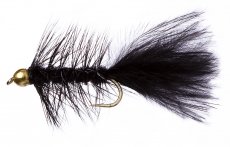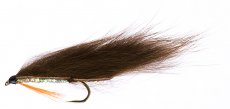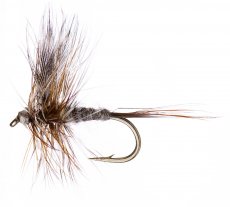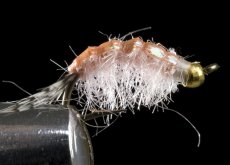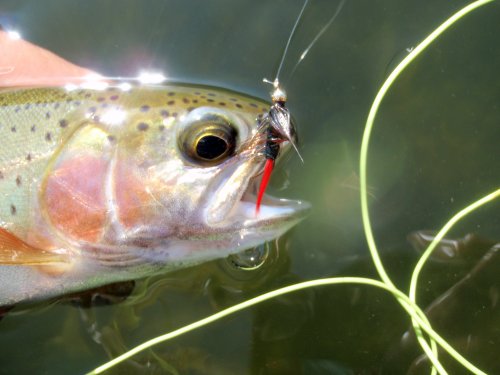The expert recommendation for fly patterns for trout fishing in Mexico.
Well after reading my article Fly Fishing for Aztec Trout you have the picture of what is it like to fish for trout in Mexico, but let us talk about the flies to fish for this Aztec trout. There are two different approaches to flies for Aztec trout, the first one is the match the hatch approach, which is the most effective one in natural places, and then there is the attractor fishing approach.
Matching the hatch is the less common approach used by Mexican anglers, most of them use attractor patterns, because the majority of them fish private lakes where fish respond well to this kind of patterns, but this is not always true, there are times when trout even in this kind of waters become very selective, especially when Chironomids are getting ready to hatch, this order is present in very large quantities in every private lake and in most natural lakes, Chironomids larva down here measures about one to two and a half centimeters and this ones are bright red in color, this ones are known in the United States as blood worms.
Another important order is Odonata which includes damsels and dragon flies. Average dragon nymph measures two centimeters, but there are really large ones, reaching seven centimeters in length, these are usually brown, black or brown-olive in color. This order is present in rivers as well as in lakes no matter the altitude or ecosystem surrounding them. The only kind of lakes that I have not seen these insects present are crater lakes. Damsel flies do not grow particularly large down here, average is one centimeter and one and a half being a large specimen. Colors for damsels run from bright green, it is so bright that you could even use a chartreuse pattern to very dark green and brown.
Mayflies are also present in our waters, from my observations I have found species belonging to seven families which are: Hepatageniidae, Baetidae, Trichrytidae, Ephemeridae, Baetiscidae, Caenidae and Leptophlebiidae this families, are of the same sizes and colors of those in North American rivers and lakes.
The order Trichoptera or caddis flies is also abundant in our waters, it is not that there are too many families in our waters, but the number of individuals of a few families with different species. The families of caddis flies present in Mexico are: Brachycentridae, Helicopsychidae, Hidropsychidae, Leptoceridae and Limmnephilidae. Bright green and tan are the most common colors of these insects, but there are also some species which are light brown, olive and black. In lakes caddis fly larvae are usually large, being a good choice a two centimeter fly, but in rivers there are smaller ones also being five millimeters the smallest size for this order.
Stoneflies are not as common as the other orders, there are very few places where you can find members of this order, and I have only determined one family present in the central area of Mexico where I fish, and it is the Perlidae family, these are not very large insects, nymphs measure about two and a half centimeters and are colored yellow with black markings on top.
There are many other orders present in our waters, among them you can find water boatmen, back swimmers, leeches, scuds, crayfish, hellgrammites and aquatic beetles and of course a good supply of terrestrial insects especially during the summer months.
Flies for catching trout in Mexico are as varied as the places you find them, but one thing common to all underwater flies is that they should be very heavily weighted specially during and after the rain season, because even if you see a very small stream with pools not larger than six feet wide, they can be very deep sometimes reaching more than ten feet.
Patterns used in Mexico are almost always creation of local anglers, but there are some patterns created in the united States and other countries that also work well down here, Wooly Buggers, Zonkers, Gold ribbed hare’s ear, Clouser swimming nymph, prince nymph, wooly worms, serendipity, Kauffman’s stones, Royal Wulff, Adams, Stimulators and many others will find a good response from Mexican trout, but there is nothing as good as local flies for local fish.
Mexican flies are tied almost always with a bead head and several turns of lead for the reasons mentioned before, dry flies even though effective are not the go to flies down here specially when fishing lakes, rivers because of their characteristics have not many areas that can be fished with dries, or at least we have not experimented enough with this kind of flies.
Materials for bodies should absorb water quickly in order to reach the depths required to fish our river during the wet season, but you should carry some weightless or slightly weighted flies to fish shallow water in lakes and rivers, this patterns become more necessary when you fish the dry season.
If I was forced to fish with just ten patterns all year long I would choose in first place the Calapa river special, named after a small but beautiful river located in the northern sierra of Puebla, this is a very successful pattern not just in that river, but everywhere you fish it, its construction allows the fly to sink fast and keep a nymph silhouette in the water, the flash on its back reflects even the smallest amount of light, this can be tied heavily weighted for the rainy season or unweighted for the dry season.
The second pattern I would choose is the Cactus Bugger, which is an attractor pattern, that can be fished weighted and unweighted and can be tied in different colors to suit the condition of the waters, this one is the go to fly in private lakes.
In third place I will choose the Thousand eyes relinquished which is a fly developed by my son, he named the fly after a monster on a card game, it is actually a bugger like fly designed to sink very fast with the point of the hook ridding up, this is a very useful fly when fish are feeding on crayfish and other bottom dwelling creatures. It can be tied in several color combinations to match the color of the forage.
Another very good pattern is the Rabbit Nymph, this is a generic nymph imitation, that sinks fast and wiggles seductively as it descends because of the rabbit strip tail, it can be tied in any color combination to match the hatch. This one is particularly good for fishing practically anywhere is an all around pattern.
Since most of our waters hold large populations of damselflies, you should never go without an imitation, and the best one I have tried is the Holo Damsel, it has a shinny underbody and also a tail and legs that wiggle with every movement of the fly line and even when it sinks, and because od the bead chain eyes sinks pretty fast, another good thing about this fly is durability, due to the materials used it is very durable.
For bloodworms I suggest you should use the Chironomid X, which is a very attractive and easy to tie imitation of the natural, and its built in flash attracts fish from great distances, with a few modifications to the original pattern you can get a pupa pattern for this order, trout sometimes just go crazy when Chironomids are hatching. You should never fish a private lake without a couple of these flies.
Since there are not many species of stoneflies down here in Mexico, all you need is one pattern to imitate the species present, you can use any of the regular stone patterns in yellow and black, but if you wish to use a local pattern you can use the scud back stone, this fly was developed to fish some rivers located in the evergreen forests, for this one there is no point in changing colors, since the stone species is the same.
Crayfish also deserves a special place in any fly box intended to fish Mexican waters for trout, the pattern I with the best success rate is the Furry Foam Crayfish which is easy to tie and can be tied in different color to match the local crustaceans. Try to weight this pattern so it falls tail down to the bottom, this action makes fish bite it with confidence.
Dragonfly nymphs area very important part of trout in Mexico, and since almost every water body holds large populations of this insect, you should carry at least one pattern to imitate it, the best pattern I have used is the Bead Eye Flashback Dragon, which has inherent flash and sinking speed so it can reach the bottom of pools or weed beds located in medium to deep water.
The last pattern I would choose is a minnow pattern, and the one I would select is the Cactus Minnow which is a very effective minnow imitation, it sinks fast but not too fast, so it gives time to the trout to take it on the fall, the shine of the holographic cactus chenille of the abdomen certainly attracts fish from great distances, also it is easy to cast even when tied in larger sizes.









